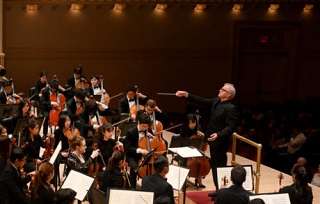|
Back
Building of elemental blocks and subtle, yearning themes New York
Carnegie Hall
02/08/2020 - & January 30, 31 (Philadelphia), February 1 (Bethlehem), 3 (Athens), 5 (Blacksburg), 6 (Durham), 2020
Gabriella Smith: f(x) = sin2x –1/x
Ludwig van Beethoven: Piano Concerto No. 5 in E-flat Major, “Emperor”, Op. 73
Jean Sibelius: Symphony No. 2, Op. 43
Jonathan Biss (piano)
Curtis Symphony Orchestra, Osmo Vänskä (conductor)

O. Vänskä (© Pete Checchia)
The program of the Curtis Symphony Orchestra at Carnegie Hall was united by the building of elemental blocks and subtle, yearning themes. It opened by a work by young Curtis graduate Gabriella Smith, a protégée of John Adams. While Beethoven’s 5th Piano Concerto is not inspired by the outdoors, Sibelius’ Second Symphony is, in part. In f(x) = sin2x –1/x by Smith, as performed under the skilled baton of guest conductor Osmo Vänskä, we hear not only the repetitive gestures of Adams and Philip Glass, but also the natural world of John Luther Adams and even Olivier Messiaen. This combination of driving rhythms and suggestive melodic bits are unique and entranced.
Pianist Jonathan Biss (also a Curtis graduate) will be performing Beethoven in Stockholm, Dresden, Rome, and Warsaw in the next months. Hearing him listen to the notes he is playing, letting them ring, waiting for them to resolve into the air, you want to hear every phrase he lofts. Working smoothly with conductor Vänskä, daring rubatos extend. Never does a note seem too quiet, although it may rest well below the decibels of a whisper. The orchestra responds to both the artist and the conductor. Instrumentalists have a subtly well beyond their years, often pubescent.
Curtis is a prestigious American institution which offers a free education to a select group of young artists. Their chances of landing a major orchestra position are far greater than the graduates of any other music school. We can hear why. Although the bows are held in random positions, shoes are often scuffed, and elegant garb often worn with a flamboyant disarray, their music is magical.
Biss performed “The Poet Speaks” (from Kinderszenen) by Robert Schumann as an encore. An excellent writer, he describes his response to the composer, an odd and broken man. He feels him. Never has “The Poet Speaks” been played with such feelingful beauty.
Sibelius’ Second Symphony followed. Like Beethoven, Sibelius is working with blocks of sound mounted successively. He too uses a repeated motif, presented in many forms and each piece joined together in a compelling jigsaw puzzle. The bassoon, the horns and the woodwinds offered varying and exciting phrases which fit well in the whole.
Vänskä drew out the three-note motif which is developed and appears in many different guises throughout the symphony. We hear it clearly as the dramatic theme of the finale. Like Beethoven’s massing of elemental structures, the piece is a jigsaw puzzle, full of mystery until the very end. The bassoon played the second movement theme, which is then picked up by walking basses. The brasses give us the theme again. It is picked up by an ethereal motif in the strings. The strings take on blistering figures at the beginning of the third movement. The oboe accompanied by clarinets and horns is by contrast lyrical. Texture, rhythm and dynamics are constantly in play. The symphony has been building to the fourth movement, taken without a pause. Its sweeping melody and rich orchestration herald the end of an immense journey. Triumphant themes, colossal, loud and regal ring out.
An exuberant performance of Sibelius’ Valse tristeand Cortège ended the evening on a high. The audience reluctantly left the hall as the young musicians finally exited from the stage, just as reluctantly.
Susan Hall
|